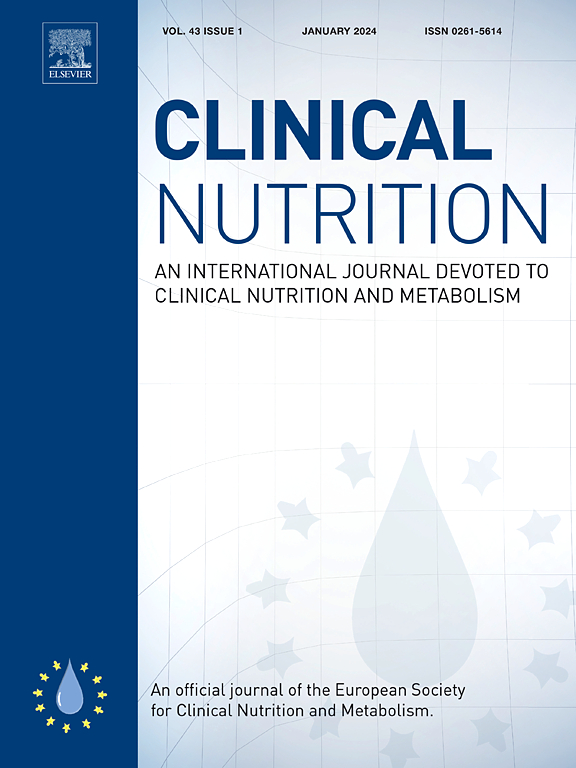The effect of oral feeding on gastrointestinal function, motility and appetite-regulating hormones, insulin, glucose and satiety in normal weight individuals and those with obesity
IF 7.4
2区 医学
Q1 NUTRITION & DIETETICS
引用次数: 0
Abstract
Background and aims
The primary aim of this study was to evaluate the effect of ingestion of a standardized meal on gastric content volume and gastric emptying time in healthy normal weight people and those with obesity. Secondary aims were to evaluate the effect of the meal on superior mesenteric artery blood flow, small bowel water content, subjective satiety, and concentrations of appetite and motility-regulating hormones (PYY, ghrelin, GLP-1, and GLP-2), blood glucose and insulin in the participants.
Methods
Ten normal weight male participants and ten with obesity were recruited. After fasted measurements participants consumed a test meal [∼500 g portion, 145 kcal (606 kJ)/100 g]. T50 gastric emptying time, gastric content volume, superior mesenteric artery blood flow and small bowel water content were measured using magnetic resonance imaging. Blood PYY, ghrelin, GLP-1, GLP-2, insulin and glucose were measured along with composite satiety scores. Measurements were repeated at regular intervals for up to 300 min.
Results
At screening, there were no differences between the groups apart from greater body weight and body mass index in those with obesity. Median ± SD T50 gastric emptying time was not different between normal weight participants and those with obesity (148 ± 16 min vs. 170 ± 15 min, respectively, P = 0.87). Gastric content volume, blood glucose, PYY, ghrelin, active GLP-1 and total GLP-2 concentrations, superior mesenteric artery blood flow, and small bowel water content, when fasted and in response to eating did not differ between groups (all P > 0.05). Repeated measures ANOVA showed no difference in postprandial blood glucose concentrations (P = 0.486) over time between the groups, but postprandial serum insulin was significantly higher (P = 0.015) in those with obesity. Composite satiety scores were significantly higher in the normal weight group immediately after eating and in the postprandial period (P = 0.015).
Conclusion
Lower meal-stimulated satiety in males with obesity could lead to greater habitual dietary intake and further weight gain and, therefore, be an important driver for the maintenance of obesity in individuals without comorbidities.

口腔喂养对正常体重者和肥胖者胃肠功能、运动和食欲调节激素、胰岛素、葡萄糖和饱腹感的影响
背景和目的本研究的主要目的是评估摄入标准化膳食对正常体重和肥胖人群胃内容物体积和胃排空时间的影响。次要目的是评估膳食对参与者肠系膜上动脉血流、小肠水含量、主观饱腹感、食欲和运动调节激素(PYY、胃饥饿素、GLP-1和GLP-2)、血糖和胰岛素浓度的影响。方法招募10名正常体重男性和10名肥胖男性。禁食测量后,参与者食用一份试验餐[约500克,145千卡(606千焦)/100克]。采用磁共振成像技术测定T50胃排空时间、胃内容物体积、肠系膜上动脉血流及小肠含水量。测定血中PYY、ghrelin、GLP-1、GLP-2、胰岛素、葡萄糖及复合饱腹感评分。结果在筛查中,除了肥胖人群的体重和身体质量指数更大外,两组之间没有任何差异。中位±SD T50胃排空时间在体重正常的参与者和肥胖的参与者之间没有差异(分别为148±16分钟和170±15分钟,P = 0.87)。空腹时和进食后的胃内容物体积、血糖、PYY、胃饥饿素、活性GLP-1和总GLP-2浓度、肠系膜上动脉血流和小肠水含量在两组之间没有差异(P >;0.05)。重复测量方差分析显示,两组间餐后血糖浓度随时间变化无差异(P = 0.486),但肥胖组餐后血清胰岛素显著升高(P = 0.015)。正常体重组在进食后和餐后的综合饱腹感评分均显著高于正常体重组(P = 0.015)。结论男性肥胖患者较低的食物刺激饱腹感可能导致习惯性饮食摄入量增加和体重进一步增加,因此,这是无合并症个体维持肥胖的重要驱动因素。
本文章由计算机程序翻译,如有差异,请以英文原文为准。
求助全文
约1分钟内获得全文
求助全文
来源期刊

Clinical nutrition
医学-营养学
CiteScore
14.10
自引率
6.30%
发文量
356
审稿时长
28 days
期刊介绍:
Clinical Nutrition, the official journal of ESPEN, The European Society for Clinical Nutrition and Metabolism, is an international journal providing essential scientific information on nutritional and metabolic care and the relationship between nutrition and disease both in the setting of basic science and clinical practice. Published bi-monthly, each issue combines original articles and reviews providing an invaluable reference for any specialist concerned with these fields.
 求助内容:
求助内容: 应助结果提醒方式:
应助结果提醒方式:


